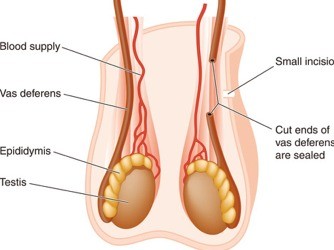 A vasectomy is a surgical procedure to stop the transfer of sperm during ejaculation. As a method of contraception it is simple, reliable (more than 99% effective), and permanent, although in some cases – but not all- it can be reversed.
A vasectomy is a surgical procedure to stop the transfer of sperm during ejaculation. As a method of contraception it is simple, reliable (more than 99% effective), and permanent, although in some cases – but not all- it can be reversed.
You should only undergo a vasectomy if you are certain that you don’t want any, or any more, children. If you have a partner, it is important to discuss the subject with her and only proceed when you have made a definite decision. Please remember that you might regret taking such a big step in reaction to a crisis or a big change in your life. Reversing the operation isn’t easy, and is seldom available on the NHS.
How Does a Vasectomy Work?
The operation works by cutting, blocking or heat-sealing the tubes that carry sperm from the testes (the sex glands in the scrotum), to the penis.
Seminal fluid, or semen, is not all made in the testicles: in fact, only 7% comes from there, the rest being made in the prostate gland and seminal vesicles, with a little help from the bulbourethral glands. After a vasectomy these will continue to make semen, which will be ejaculated from the penis during sex as usual.
Your testicles will still produce sperm, which they simply reabsorb in a natural way. But the semen will contain no sperm, so a woman’s egg can’t be fertilised.
About the Vasectomy Operation
Most vasectomies only last around 15 – 30 minutes. They are carried out under local anaesthetic and only your scrotum and testicles will be numbed. The surgeon makes two, 1cm long incisions, one on each side of your scrotum.
Using microsurgery, each of the vas deferens – the tubes that carry sperm out of your testicle – is cut and a small section removed. The ends of the tubes are then closed, either by tying them or sealing them using diathermy (an instrument that heats to a very high temperature). The incisions are stitched, usually with dissolvable sutures.
The No Scalpel Vasectomy
This is a newer technique wherein the surgeon feels for the vas deferens underneath the skin of the scrotum and then holds them in place with a small clamp. The skin of the scrotum is punctured and a minute pair of forceps is used to open up the tiny hole.
The tubes are then closed in the same way as in a conventional vasectomy, either by being tied or sealed. Without the need to cut the skin with a scalpel there is little bleeding and no stitches, the procedure is less painful, and less likely to cause complications.
Post Op
The patient usually goes home the same day, can shower on the evening of the operation, and should be able to return to work in two to three days. There may be some pain and swelling, which should respond to painkillers. Supportive underpants should be worn night and day until the tiny puncture wounds have healed.
After the operation your semen is checked to make sure it’s free from sperm, which can stay in the tubes leading to the penis. However, these tests can take up to twelve weeks to complete, so alternative contraception should be used for at least eight weeks after the operation until you are given the all clear.
What About my Sex Life?
After the swelling has subsided, your sex drive, erection and ability to enjoy sex remains as it always was, and semen is still produced on ejaculation. But please remember a vasectomy does not protect against sexually transmitted diseases, including HIV.
